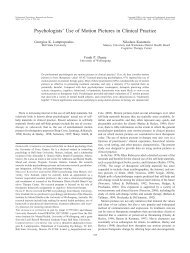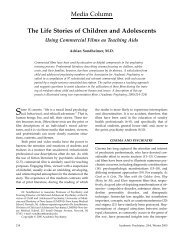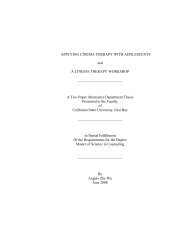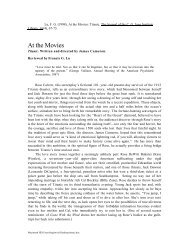Content Analysis of Romantic Comedies IN PRESS ...
Content Analysis of Romantic Comedies IN PRESS ...
Content Analysis of Romantic Comedies IN PRESS ...
Create successful ePaper yourself
Turn your PDF publications into a flip-book with our unique Google optimized e-Paper software.
<strong>Content</strong> <strong>Analysis</strong> <strong>of</strong> <strong>Romantic</strong> <strong>Comedies</strong> 14was comparatively smaller than “<strong>Romantic</strong> Speech”, which contained the more romanticverbal gestures. The greater frequency <strong>of</strong> romantic verbal gestures such as compliments andsweet nothings may lead adolescents to place more importance on them in relationships thanon open communication between partners.“Expression <strong>of</strong> Emotions” was created when several open coding categories werenoticed to depict characters expressing their feelings about their relationships (as listed inTable 2). Characters were shown to be visibly happier when in a relationship or excited at theprospect <strong>of</strong> a new relationship forming. For example, in The Wedding Planner a characterarrives at work the day after a date and colleagues comment on her appearing noticeablyhappier, more carefree and that she “can’t stop smiling”. This contrasts from the depictions<strong>of</strong> single characters who were typically shown to be unhappy or frustrated, potentially furtherinfluencing the negative attitudes towards being single discussed earlier.Several open coding categories, upon closer examination, appeared to represent theimportance individuals placed on their partners. These were grouped together under the axialcategory “Importance <strong>of</strong> Partner”. Characters were quickly loyal to their partners, defendingthem to others (such as in 10 Things I Hate About You, where a character defends the girl heis interested in when a friend speaks derogatively <strong>of</strong> her). Partners preoccupied characters’thoughts (such as in Keeping The Faith, where a character appears distracted at work whilewaiting for her partner to meet her) and their opinions became important (such as in Clueless,where two characters change their appearance in response to comments each has made <strong>of</strong> theother). Characters also prioritised their relationships and partners over other areas in theirlife. For example, in Mr. Deeds, a character gives up her career and moves to be with theman she loves. Such instances outnumbered those depicting characters prioritising careersover partners, such as in Picture Perfect where a character ends her relationship due to “badtiming”. However, even in such cases work is only initially prioritised over a relationship asby the end <strong>of</strong> the film the relationship is ultimately chosen over all else.










